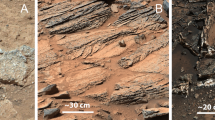Abstract
There is a pair of binocular cameras for navigation onboard the Chang’e-4 lunar rover. Although the cameras were calibrated before launch, it is necessary to calibrate them again after landing on the moon, especially the external parameters. In this article, an image of a solar panel containing parallel-line features is used for recalibration. According to the collinear equations of an image point, object point and projection centre, the algebraic relationship between the slope k and intercept t parameters of a line in the image and the external parameters of the cameras are deduced. Through this algebraic relationship, we propose an external parameter recalibration method based on an image that includes parallel lines on a plane in the object space. Three experiments were carried out to evaluate the effectiveness and reliability of the proposed method.
Zusammenfassung
Neukalibrierung der externen Parameter des Stereokamerapaars des Chang'e-4 Mondrovers. Auf dem Chang’e-4 Lunar Rover befindet sich ein Stereokamerapaar zur Navigation. Obwohl die Kameras vor dem Start kalibriert wurden, müssen sie nach der Landung auf dem Mond erneut kalibriert werden, insbesondere die externen Parameter. In diesem Artikel wird das Bild eines Solarmoduls, das Merkmale paralleler Linien enthält, zur Neukalibrierung verwendet. Gemäß der Kollinearitätsgleichung des Bildpunkts, des Objektpunkts und des Aufnahmezentrums wird die algebraische Beziehung zwischen den beiden Linienparametern im Bild, der Steigung k und dem Achsenabschnitt t, und den äußeren Parametern der Kamera hergeleitet. Basierend auf dieser algebraischen Beziehung schlagen wir ein Rekalibrierungsverfahren für externe Kameraparameter auf der Grundlage von Bildern vor, das parallele Linien auf einer Ebene im Objektraum nutzt. Schließlich wurden drei Experimente durchgeführt, um die Leistungsfähigkeit und Zuverlässigkeit der vorgeschlagenen Methode zu bewerten.








Similar content being viewed by others
References
Caprile B, Torre V (1990) Using vanishing points for camera calibration. IJCV 1990:127–140
Chen T, Shibasaki RS (1998) Determination of camera’s orientation parameters based on line features. Int Arch Photogram Remote Sens 32(5):23–28
El-Hajjouji I, Mars S, Asrih Z, El-Mourabit A (2020) A novel FPGA implementation of Hough Transform for straight lane detection. Eng Sci Technol Int J 23:274–280
El-Hakim SF (1985) A photogrammetric vision system for robots. Photogramm Eng Remote Sens 51(5):545–552
Elnima EE (2015) A solution for exterior and relative orientation in photogrammetry, a genetic evolution approach. J King Saud Univ Eng Sci 27:108–113
Feng XF, Pan DF (2018) A camera calibration method based on plane mirror and vanishing point constraint. Optik 154:558–565
Gatilov SY (2014) Using low-rank approximation of the Jacobian matrix in the Newton-Raphson method to solve certain singular equations. J Comput Appl Math 272:8–24
Gonçalves MLN, Menezes TC (2020) Gauss-Newton methods with approximate projections for solving constrained nonlinear least squares problems. J Complex 58:1–21
Grussenmeyer P, AI-Khalil O (2002) Solutions for exterior orientation in photogrammetry: a review. Photogram Rec 17:615–634
Guo Y (2019) A minimal solution for plane motion and structure from two perspective views. Pattern Recogn Lett 120:96–103
He BW, Li YF (2008) Camera calibration from vanishing points in a vision system. Optics Laser Technol 40:555–561
Ji Q, Costa MS, Haralick RM, Shapiro LG (2000) A robust linear least squares estimation of camera exterior orientation using multiple geometric features. ISPRS J Photogramm Remote Sens 55:75–93
Kubik K (1991) Relative and absolute orientation based on linear features. ISPRS J Photogramm Remote Sens 46:199–204
Larin VB (1999) Algorithm for solving algebraic Riccati equation which has singular Hamiltonian matrix. Syst Control Lett 36:231–239
Lee CN, Haralick RM (1996) Statistical estimation for exterior orientation from line-to-line correspondences. Image vis Comput 14:379–388
Lee SJ, Hwang SS (2020) Fast and accurate self-calibration using vanishing point detection in manmade environments. Int J Control Autom 18:1–12
Li Y, Tong GF, Sun AA, Ding WL (2018) Road extraction algorithm based on intrinsic image and vanishing point for unstructured road image. Robot Auton Syst 109:86–96
Niu YQ, Zheng B (2021) A new randomized Gauss-Seidel method for solving linear least-squares problems. Appl Math Lett 116:1–7
Robinson AW (1998) JavaFit: a platform independent program for interactive nonlinear least-squares fitting using the Levenberg-Marquardt method. Comput Phys Commun 112:183–190
Rother C (2002) A new approach to vanishing point detection in architectural environments. Image vis Comput 20:647–655
Shen YQ, Ypma TJ (2019) Solving separable nonlinear least squares problems using the QR factorization. J Comput Appl Math 345:48–58
Smith MJ, Park DWG (2000) Absolute and exterior orientation using linear features. Int Arch Photogram Remote Sen 33:850–857
Sun J, Wang HP, Zhu XL (2021) A fast underwater calibration method based on vanishing point optimization of two orthogonal parallel lines. Measurement 178:1–19
Tsai RY, Huang TS, Zhu WL (1982) Estimating three-dimensional motion parameters of a rigid planar patch, II: singular value decomposition. Acoust Speech Signal Process IEEE Trans 30(4):525–534
van den Heuvel FA (1998) Vanishing point detection for architectural photogrammetry. Int Arch Photogram Remote Sens 32(5):652–659
You XH, Zheng Y (2016) An accurate and practical calibration method for roadside camera using two vanishing points. Neurocomputing 204:222–230
Yu QD, Xu GL, Cheng YH (2020) An efficient and globally optimal method for camera pose estimation using line features. Mach vis Appl. https://doi.org/10.1007/s00138-020-01100-6
Yu QD, Xu GL, Wang ZS, Li ZH (2021) An efficient and globally optimal solution to perspective-n-line problem. Chin J Aeronautics 35(3):400–407
Zhang S, Jia Y, Peng S, Wen B, Ma YQ, Qi C, Sima B, Liu SC (2020) Self-Calibration of the stereo vision system of the Chang’e-4 Lunar Rover based on the points and lines combined adjustment. Photogramm Eng Remote Sens 86(3):169–176
Acknowledgements
This work was supported by the National Natural Science Foundation of China under Grant 42071447.
Author information
Authors and Affiliations
Corresponding author
Rights and permissions
About this article
Cite this article
Yan, Y., Qi, C., Ma, Y. et al. External Parameter Recalibration of the Binocular Cameras Onboard the Chang’e-4 Lunar Rover. PFG 90, 293–303 (2022). https://doi.org/10.1007/s41064-022-00199-8
Received:
Accepted:
Published:
Issue Date:
DOI: https://doi.org/10.1007/s41064-022-00199-8




